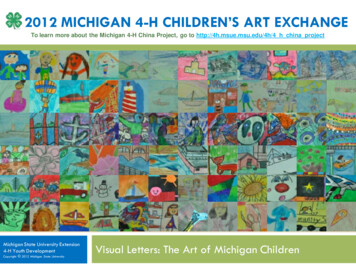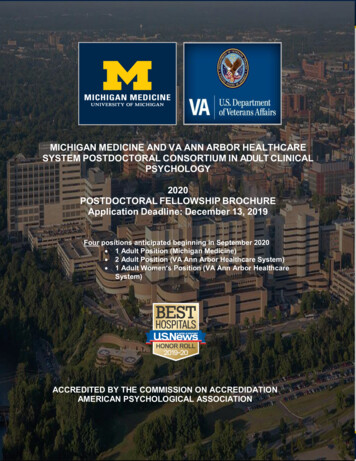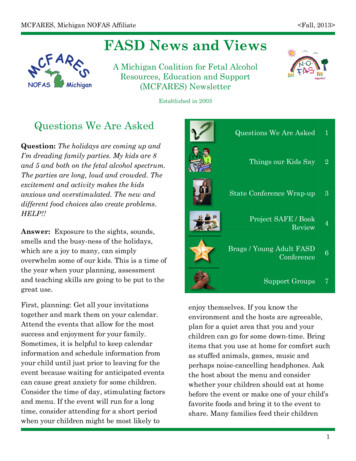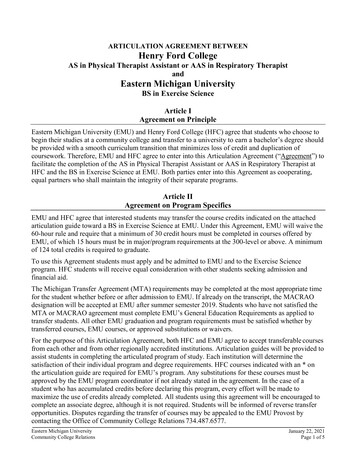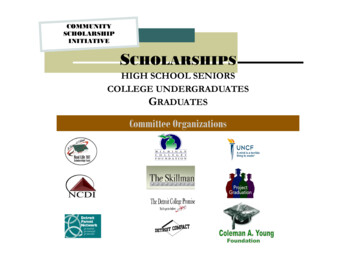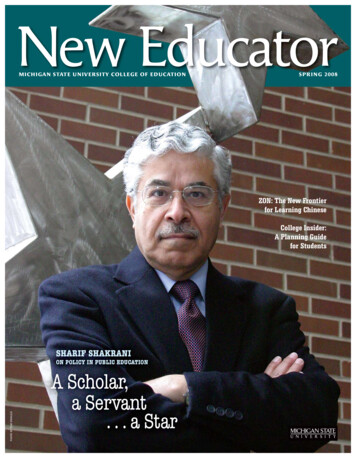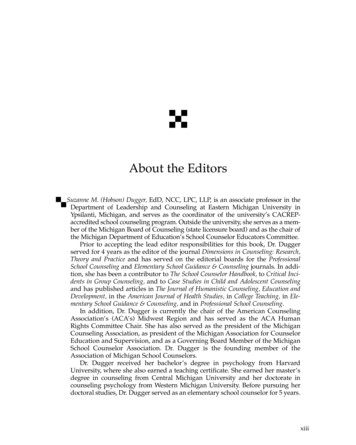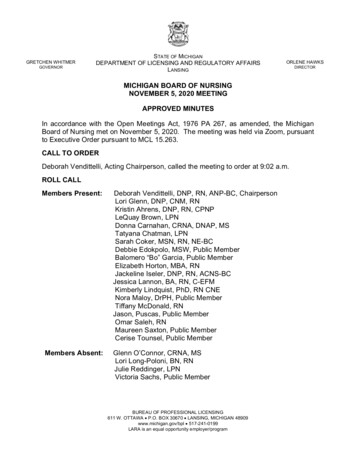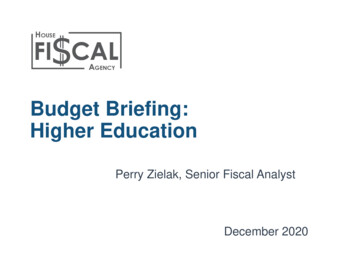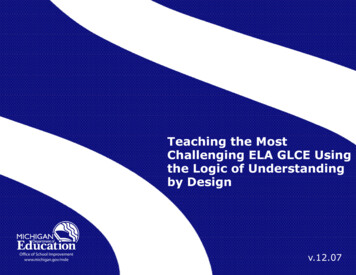
Transcription
Teaching the MostChallenging ELA GLCE Usingthe Logic of Understandingby DesignOffice of School Improvementwww.michigan.gov/mdev.12.07
Mastering Michigan’s Challenging GLCEUsing the ‘Big Ideas’ of Understanding by DesignTable of ContentsIntroduction .Pages i – iii4th Grade Narrative Text Lessons Compendium of Narrative Strategies .Pages 1-6Pages 7-345th Grade Comprehension Lessons .Compendium of Comprehension Strategies .Pages 35-39Pages 40-736th Grade Informational Text Lessons .Compendium of Informational Strategies .Pages 74-78Pages 79-857th Grade Grammar in Context Lessons .Compendium of Grammar Strategies Pages 86-90Pages 91-104v.12.07
An Introduction to Teaching the Most Challenging ELA GLCEUsing the Logic of Understanding by DesignIntroductionThe Michigan K-8 Grade Level Content Expectations (GLCE), for the first time, required grade-level specific learningrequirements for elementary and middle-school students. After examining a sample of Michigan EducationAssessment Program data aligned to the GLCE, it was noted that specific domains showed patterns of nonachievement across a broad spectrum of the student population. Powerful expectations require powerfulinstructional approaches. The GLCE Understanding by Design Committee, therefore, designed example lessons forchallenging GLCE assessed at grades 4, 5, 6, and 7. We hope the lessons within this document serve as aninspiration for designing more lessons aimed specifically at raising English language arts achievement.ProcessThe GLCE Understanding by Design Committee, Michigan educators, worked collaboratively to design lessons foundwithin this document using research and best practices from the English language arts, as well as, theUnderstanding by Design (UbD) philosophy to address students’ learning needs. Educators worked in grade-levelteams to collaboratively consider best practices for addressing the learning targets suggested in the mostchallenging expectations for each grade level. Lessons are presented as a series of learning experiences. Eachexperience provides focus questions, learning targets, performance indicators, and learning activities which areinfused with creditable literacy strategies. Templates for these strategies are provided in the appendices for eachgrade level document.Understanding by Design FrameworkWiggins and McTighe, 2004, offer an effective framework for designing instruction through “Backward Design.” Thedesign process seems “backward” in that it starts from the opposite end of the planning process typically used toplan instruction—educators traditionally start by thinking about how to teach content. Backward Design, in contrast,leaves teaching activities until the end, starting with the learning results expected. The writers used BackwardDesign process which proceeds in the following three phases:STAGE I: Identify Desired ResultsFirst, learning goals must be established. What should students know, understand and be able to do? How iscontent prioritized and narrowed down to reflect priorities of the standards and learning expectationsv.12.07i
(GLCE)? Wiggins and McTighe provide a useful process for establishing curricular priorities. They suggest threequestions that facilitate the design of learning goals and progressively “focus-in” on the most valuable content:1. What should participants hear, read, view, explore, or otherwise encounter? This knowledge is “worth beingfamiliar with.”2. What knowledge and skills should participants master? Sharpen choices by considering what is “important toknow and do” for students. What facts, concepts, and principles should they know? What processes,strategies, and methods should they learn to use?3. What big ideas and important understandings should participants retain? These choices are the “enduringunderstandings” that students should remember.STAGE II: Determine Acceptable EvidenceIn phase two of Backward Design, educators decide what is acceptable evidence to help gauge that students aremeeting the lesson goals? How will one know if students are “getting it”?When planning how to collect this evidence, consider a wide range of assessment methods and directly alignassessment to the learning to be gained. Assessments must match learning goals.STAGE III: Plan Learning Experiences and InstructionFinally, after deciding what results are desired and determining the evidence for achievement of those results, startplanning how to teach to reach those outcomes. That is, move to designing instructional strategies and students’learning activities. Devise active and collaborative exercises that encourage students to grapple with new conceptsand significant understandings.One Good Electronic Source for UbD uitem.6a270a3015fcac8d0987af19e3108a0c/;jsessionid FSiAMRC2Qv.12.07ii
Example Resources for Initiating a Study of Best Practices and Strategy Instruction:Keene, E. & Zimmermann, S. (1997). Mosaic of thought: Teaching comprehension in a reader’s workshop.Portsmouth, NH: Heinemann.Harvey, S. & Goudvis, A. (2007). Strategies that work: Teaching comprehension for understanding andengagement. Portland, ME: Stenhouse Publishers.Marzano, R., Norford, S., Paynter, D., Pickering, D., & Gaddy, B. (2001). A handbook for classroominstruction that works. Upper Saddle River, NJ: Pearson/Merrill Prentice Hall.Tankersley, K. (2005). Literacy strategies for grades 4-12: Reinforcing the threads of reading. Alexandria,VA: ASCD.v.12.07iii
Hitting the Learning Targets In Michigan’s Challenging ELA GLCETitle: Aesop Meets Assessment: Understanding Narrative GenreGLCE Domain: Narrative TextGLCE Codes Assessed At Grade 4:R.NT.03.02: Identify and describe the basic elements and purpose of a variety of narrative genre including folktales, fables,and realistic fiction.R.NT.03.03: Identify and describe characters' thoughts and motivations, story level themes (good vs. evil), main idea, andlesson/moral (fable).R.NT.03.04: Explain how authors use literary devices including prediction, personification, and point of view to develop astory level theme, depict the setting, and reveal how thoughts and actions convey important character traits.Brief Lesson Summary Including Curricular Context & Goals:Students will be able to identify, describe, and write a variety of genre (e.g., fable, folktale, and realistic fiction), explaining andusing appropriate literary devices, and will understand how literature communicates values and cultural themes across time.Stage 1—Desired ResultsWhat understandings are desired?Established Goals Aligned To GLCE Domain:Students will understand that narrative genres have different audiences, purposes, and text structures while sharing commonstory elements. Narrative text is classified by distinguishing genre features. Literary devices are used to reveal characters’ traitsand motives. Understanding common story elements and distinguishing genre features aids comprehension.Understandings:Essential Questions:Students will understand that What essential questions will be considered? Common values exist across cultures and time and are Why are stories told?passed on through oral and written stories. What are the characteristics that differentiate between folktales, Authors write for an audience and purpose.fable, and realistic fiction (literary genre)? Literature can be classified by common story elements What common story elements are shared across narrative texts?and distinguishing genre features. What distinguishing features allow us to classify narrative text by Realistic Fiction portrays life as it has been, is, orgenre?could, realistically be. How can text structure reveal genre? How is culture revealed in text? How are literary devices used to reveal characters’ motives andtraits? How can understanding genre, literary devices, and text structureaid comprehension?What key knowledge and skills will students acquire?Students will know Students will be able to That narrative genres share common elements. Identify and describe the purpose, basic elements, and How to classify genres by story elements anddistinguishing characteristics of a variety of narrative genre. Explain the purpose of literary devices (Personification, prediction,distinguishing features.v.12.071
How to identify and use literary devicespoint of view, to develop theme, setting, and to reveal important(personification, point of view, prediction) for specificcharacter traits).purposes. Identify and describe characters’ thoughts and motivations, story That culture is depicted through story language.themes (good vs. evil), main idea, and life lesson/moral. That life lessons are common across cultures. That life lessons have been passed through oraltradition in cultures around the world.Stage 2— Assessment EvidenceWhat evidence will show that students understand?Performance Task:You are a writer with a specific audience and purpose in mind. Using what you have learned about narrative genre, write aneffective fable, folktale or work of realistic fiction using appropriate literary devices and key characteristics of each of the gradelevel narrative genre to reveal your characters’ traits, thoughts, and motives.Key Criteria: Substantive discussion and quality of individual response based upon the ability to generate and answer high-level questionsabout the characteristics of specific narrative genre, as well as main idea, and lesson/moral of the piece. Effective retelling of the defining characteristics of grade-level narrative genre, and identifying examples of these frompreviously unread text samples. Effectively using internalized processes, and peer and teacher response, to improve quality of writing and replication of thetraditional elements and characteristics of the narrative genre being studied through the editing process. Demonstration of knowledge through effective replication of specific elements, literary devices (prediction, personification, andpoint of view), and characteristics of the genre, including the audience’s endorsement (insightful writing pieces and journalentries composed in alignment with mini-lessons addressing specific skills). Identify aspects of text themes, settings, and character traits/development as students study each new narrative genre. High ratings on compositions using standardized MEAP and other designated rubrics.Other Evidence (quizzes, tests, prompts, observations, dialogues, work samples, etc.)Informal, ongoing evidence of the following: Understanding of genre definitions (see www.michigan.gov/glce or www.michigan.gov/ela) demonstrated throughidentification of examples in previously unread pieces. Observations revealing individual & cooperative discussions using higher-order cognitive responses. Well developed writing to learn responses in journals used in processing ideas in deep discussions. Engaged learning through infusion of technology: Webquests, interactive media, response to digital story boards, andpodcasts. Evidence of metacognitive processes and high-level work samples.Student Self-Assessment and Reflection I can produce quality writing pieces and journal entries effectively incorporating appropriate genre characteristics. I can revise my written drafts to include traditional characteristics of fables, folktales, and realistic fiction. I can explain the differences between fables, folktales, and realistic fiction.v.12.072
I can explain and use prediction, personification, and point of view to develop and link a story level theme, characterizationand setting. I can self-evaluate using rubrics. I can use inquiry processes to enhance content and presentation of my writing.Stage 3— Learning PlanWhat evidence will show that students understand?Experience 1: Fable FunFocus Question: What are the elements of a fable? What makes it a fable? How is it different from realistic fiction (RF)?Learning Target: I can identify key characteristics of a fable and use these to generate a genre definition.Performance Indicator: Students accurately identify story elements and explain distinguishing characteristics of a fable.Learning Activities: Facilitate a discussion and analysis based upon the following guiding questions:1. What common story elements (Story Chart) are found in narrative text (characters, setting, problem, solution)?2. Identify the defining characteristics of characters, settings, problems, etc, for grade-level genre through acompare/contrast procedure.3. What specific characteristics do we find in fables that we do not find in realistic fiction? Begin with fables. Students view “Aesop’s Fables” (video or multi-media); discuss. Read fables aloud, think aloud to model, then ask students to note similarities in characters/story line; discuss. Generalize from details found in texts and multimedia (Reading Between the Lines), then ask students to write their owngenre definition for fables. Think-Pair-Share to discuss. Compare definitions to those in Michigan’s Genre Project(www.michigan.gov/glce or www.michigan.gov/ela).Strategies: Genre KWL; Compare/Contrast Text Analysis Story Chart; Think Aloud (metacognitive modeling); Reading Betweenthe Lines; Think-Pair-ShareExperience 2: Lessons For LifeFocus Question: What is a moral (life lesson) and how are they taught through fables?Student Learning Target: I can identify a fable’s life lesson and explain how it applies to my life.Performance Indicator: Students will read/view a fable and relate the moral or message to life.Learning Activities: Review definition of a fable (Connecting the New to the Known). What more did you learn? Why are fables written or told? Discuss audience, purpose, and the following questions: What is a moral (life lesson)? Are morals important in life? Read/ view multicultural fables. Students note life lessons, morals, and messages. Add to your Story Chart. Reflect on the fable’s origin, the characters’ motives, and the students’ connections to the life lessons. Engage in concept development. List titles that are, or are not examples of fables (see Frayer’s Model).Strategies: Connecting the New to the Known; Frayer’s Model (Concept Development); Synthesis.Experiences 3: Common GroundFocus Questions: What common lessons are portrayed in fables from around the world?v.12.073
How does story language reveal cultural origin?Student Learning Target: I can classify fables by culture and explain common themes across cultures.Performance Indicator: Classify text by culture, identification of common lessons presented through multicultural texts.Learning Activities: (See Common Ground organizer in appendix) Provide assorted multicultural fables. Students read, then sort and classify texts by origin and common theme. Students record characters, moral, culture, and connection to life; present findings and discuss common themes. Compare story language to identify different cultural origins. Why do common themes endure across time and cultures?Strategies: Common Ground Organizer (noting similarities/classification)Experience 4: The Sly FoxFocus Question: What are literary devices and how are they used?Learning Target: I can identify/describe literary devices that reveal characters traits, thoughts, motivations, and point of view.Performance Indicator: Students identify and explain common fable characters (animals), devices, and how the authorreveals characters’ traits, motivations, thoughts, and point of view.Learning Activities: Discuss character traits typically found in a fox (go to website below, click on fox on home s/yreaders/aesop/index.html How does story language reveal these traits? Model a Think Aloud (metacognitive modeling); demonstrating the discovery of story language clues that reveal characters’traits, thoughts, motivation, and point of view. Analyze a key character to display aspects of character. Visualize and role-play the text being read to reveal the personification (see www.michigan.gov/glce; Michigan’s GenreProject, p.19) point of view, thoughts, and motivation; apply to multicultural texts.Strategies: Think Aloud (metacognitive modeling); Understanding a Character (inference, cause/effect thinking in characteranalysis); Literacy Devices for Understanding a Character (analysis/synthesis of literary devices); Visualization; “Becoming theBook” (assuming characters’ roles and acting it out) through Role-Play (Wilhelm, 1996).Experience 5: Fabulous FablesFocus Question: What literary devices can I use to write a fable and why?Learning Target: I can use literary devices to reveal and predict characters’ traits, thoughts, and motivations.Performance Indicator: Given the fable, students work in teams to decide the characters’ roles to develop understanding oftheir traits and motivation. The impact of personification (or anthropomorphism), thoughts, and points of view are discussed.Learning Activities: Class completes the Understanding a Character analysis listing common characters and literary devices used in fables. Students write and act out a fable using specific literary devices and explain their reasoning. Present to peers through Think-Pair-Share and report out. See the following online site for information on fable Fables/Fables.htmStrategies: Character Analysis through Understanding a Character; Application of Learning (about fables) through Writing;“Becoming the Book” (assuming characters’ roles & act out) through Role-Play (Wilhelm, 1996); Think-Pair-Share.v.12.074
Experience 6: Seeing True Colors!Focus Question: In Realistic Fiction (RF), are characters’ traits, thoughts and motives revealed in the same ways as in fables,or differently?Learning Target: I understand the process of character analysis in RF and fables.Performance Indicator: Given selected RF, students identify and describe literary devices used, relating character traits ormotives revealed. Students draw informed and accurate conclusions about differences and processes.Learning Activities: Analyze characters from fables and RF using Understanding a Character handout. Discuss how RF is different from a fable. What are common story elements and genre features of RF? Students define RF in their journals. Are characters’ traits, thoughts, motives, and points of view revealed the same ways, as in a fable, or differently? Given evidence from the text, predict how characters will respond or act. Think aloud about the author’s use of literary devices revealing characters’ motives and thoughts; discuss. Students use details from texts to support answers to focus question. Synthesize information collected about characters.Strategies: Understanding a Character; Literacy Devices for Understanding a Character; Predicting Characters Response; ThinkAloud (metacognitive strategies); Synthesis.Experience 7: Why’d He Do That?Focus Question: What literary devices are used to reveal characters’ traits, thoughts, and motives in my RF reading selection?Learning Target: I can identify and accurately record the literary devices used to reveal characters traits, thoughts, andmotivations in RF.Performance Indicator: Given self-selected RF, students identify literary devices used and characters’ traits/motives.Learning Activities: Students read self-selected RF noting literary devices in Marginalia or sticky notes throughout the text. Share in large group, analyzing authors’ use and purposes of common literary devices. Teacher records on chart paper.Strategies: Marginalia; Purposes of Literary Devices Chart.Experience 8: Of Rabbits and RoostersFocus Question: What literary devices are used to reveal characters’ traits, thoughts, and motives in folktales?Learning Target: I can identify literary devices used to reveal characters traits, thoughts, and motivations in folktales.Performance Indicator: Given model multicultural folktales, students identify literary devices used to portray characters’traits, and to reveal thoughts and motives.Learning Activities: Discuss: What is a folktale? Discuss, define, compare/contrast with fables. Given a folktale, students work with partners to read/view; continue to complete the Compare/Contrast Story Chartidentifying common story elements and specific genre characteristics. Discuss, clarify. Students re-read text to identify and respond to literary devices using marginalia and/or sticky notes. Students independently respond to multicultural folktales using Story Map and Understanding a Character analysis handout.Strategies: Compare/Contrast Story Chart; Clarification through Discussion; Story Map; Understanding a Character;v.12.075
Marginalia.Experience 9: Reading For MeaningFocus Question: How can understanding specific genre characteristics help us gain clear meaning when reading?Learning Target: I can use common story elements and specific genre characteristics to understand narrative text.Performance Indicator: Students will explain/describe differences in narrative genre, and how anticipating common storyelements and specific genre characteristics can help to clarify the understanding of a story.Learning Activities: Given fables, folktales, and RF, students partner to classify/describe features that help them label each text genre. Collaboratively, students answer: How do characters’ traits/behaviors and genre characteristics help us anticipate elementsand story structures in specific genre? Use Michigan’s Genre Project to identify characteristics and develop a three-circleVenn diagram identifying similarities/differences and classifying attributes of fable, folktale, and RF.Strategies: Clarification/ Prediction through Discussion; Questioning (QAR, etc.); Classification using Venn Diagram.Experience 10: Worlds Of WritingFocus Question: How can I use what I have learned to write a fable, folktale, or realistic fiction?Learning Target: I can write specific genre pieces using literary devices to reveal characters’ traits, thoughts, and motives.Performance Indicator: Students apply their knowledge of specific elements/characteristics in their rough drafts and explainliterary devices used in their piece during writing conferences.Learning Activities: Students use the writing process to write a fable, folktale, or realistic fiction that replicates findings of their inquiries intocharacters and text elements in the particular grade-level genre. Determine audience and purpose, and preplan to focus their writing accordingly (prewriting). Students highlight specified story elements as they compose their rough drafts. Writing is self, peer, and teacher evaluatedusing an appropriate writing rubric to analyze and improve drafts. The genre pieces will be “published” for authentic audiences in differentiated formats: e.g., oral presentations, digitalstorytelling, webquests, plays, or podcasts.Strategies: Application of Learning through Writing; Writing Conference; Writing Process; Multiple Drafts; Assessment forLearning; Technology Infusion.Culminating Activity (optional)Analyze a current fable (e.g., Shrek) and design a project that displays similarities/differences in comparison to the originaltexts chosen for earlier lessons (e.g. parody). Provide an oral presentation, digital storytelling, webquest, play or podcastformat that will be presented to, evaluated, and reflected on, etc. by classmates.v.12.076
Compendium of Strategiesv.12.077
Experience 1Genre KWLWhat is it? Students access prior knowledge, set goals for learning, and reflect on what they have learned.Why use it? The charting helps students retrieve information about the topic from memory. They record informationbrainstormed and set specific purposes for further inquiry. Students consolidate their learning by reflecting on and recordingthe new learning.How to do it: Students inquire into text and record information in the chart based on the prompts in column headings. Studentsbrainstorm what they Know, what they Want to know, and what they have Learned.Genre being studied .List SpecificCharacteristics/ElementsWhat I know.What I want toknow.What I have learned.(e.g., characters, setting,theme,etc.) Go to www.Michigan.gov/glce, Michigan’sGenre Project)v.12.078
Experiences 1 & 8Compare/Contrast Text Analysis Story ChartWhat is it? This is an organizer that provides the ability to compare story elements across genre.Why use it? It enables students to capture evidence from the text for each of the elements so that likenesses and differencescan be noted.How to do it: Teachers expose students to models of the genre(s) under study. Students identify examples that correlate withthe column 12.079
Experiences 1 & 6Think AloudWhat is it? This is a strategy to show students how a good reader thinks about a story and clarifies meaning as they read. Thestrategy demonstrates how skillful readers activate background knowledge, ask questions, draw conclusions, etc. Think Aloudsdemonstrate reactions, questions, wonderings, confusions, connections or are strategy-specific.Why use it? Students will learn strategies better if they are modeled. Students increase their abilities to know when, why, andhow to ask questions if they have observed an example.How to do it: Ask students to watch carefully as you model your thinking. They should be instructed to notice what you do as a reader. The teacher selects a picture book to read out loud. Directions – explain to students that you are going to read a story and show them your thinking. They might hear youasking questions or making meaning of the story as you read, however they should not interrupt you. The teacher pauses throughout the book to make predictions, ask questions, clarify thinking, make meaning of the story,infer, evaluate, and synthesize. You are thinking out loud (having a conversation with yourself) for the students to listento your thoughts as you read. Jot down thoughts on sticky notes or in the margins to leave your “thinking tracks” (marginalia) and stay on top of themeaning. Show how to read with a question in mind, noting that some questions are answered through the reading of the text,while others are not. Show how one question leads to others. Demonstrate how to infer meaning when reading unfamiliar words. Show how to use illustrations, photos, and features to draw conclusions. Verbalize confusions and how to use fix-up strategies. Model how to pick out the information you want to remember. Show students how to merge what is known with new information. Demonstrate how thinking changes as you read. Share how attention can lag and how thoughts can stray from the text so that the students can see how to get back ontrack.Examples: See Strategies that Work (Harvey and Goudvis, 2007, pp. 46-47)v.12.0710
Experience 1Reading Between the LinesWhat is it? This strategy includes merging prior knowledge with text clues using mental imagery from words and thoughts tocome up with an idea that is not stated in the text, e.g., making a prediction, drawing a conclusion, using context to figureout meaning, or noticing characters’ actions to understand theme. Inferring can incorporate reading faces, body language,expressions, and tone, as well as, the text.Why use it? Reading Between the Lines strategies scaffold comprehension.How to do it: Visualize to picture missing information. Use all of the senses to comprehend the text (see, hear, feel, smell and taste). Use all aspects of the text to develop meaning (pictures, quotes, text, text clues). Chart background knowledge, text clues, and inferences in three-column format. Compare the differences between plots and themes. Determine the big idea. Use sticky notes to question the text and author. Reread to clear up misconceptions. Look for evidence that students are drawing and writing about their mental images, inferring meaning from unfamiliarwords, and using context to figure out complex concepts. Have students demonstrate the text evidence used in inferring themes, messages, lessons, or big ideas. Encourage role plays, scenario reenactment, charades, etc. as demonstrations of accurate reading between the lines.Examples: See Strategies that Work (Harvey and Goudvis, 2007, pps. 93-100)v.12.0711
Experiences 1 & 5Think-Pair-ShareWhat is it? This is a strategy to help students clarify their thinking and/or explain their opinion.Why use it? Students verbalize their thoughts to a partner. This helps them understand the text on a deeper level; they areactive not passive learners, because they must explain to their partner the need to read and think about the text beforediscussing it.How to do it: Materials and structure – no materials needed.Directions – give prompt or explain assignment to students. Allow enough time for individual thought, then havestudents face a partner and each person discusses their thoughts.Examples:Read prompt to students, allow enough time for them to think of an answer. Have students turn to their partner and each willtake a turn explaining their answer.v.12.0712
Experience 2Connecting the New To the KnownWhat is it? These are strategies that use our personal and collective experience to construct meaning. The strategy includesactivation of background knowledge and making connections.Why use it? It helps students overcome obstacles to understanding when they make indifferent or apathetic connections.How to do it: Illustrating, then comparing with others, to show and clarify connections to life.Using sticky notes to jot down new learning and inner conversations; then sharing with peers.C
Understanding by Design Framework Wiggins and McTighe, 2004, offer an effective framework for designing instruction through “Backward Design.” The design process seems “backward” in that it starts from t
